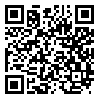Volume 14, Issue 2 (Mar & Apr 2024)
J Research Health 2024, 14(2): 147-160 |
Back to browse issues page
Download citation:
BibTeX | RIS | EndNote | Medlars | ProCite | Reference Manager | RefWorks
Send citation to:



BibTeX | RIS | EndNote | Medlars | ProCite | Reference Manager | RefWorks
Send citation to:
Khatti-Dizabadi F, Yazdani-Charati J, Fathizadeh S, Mostafavi F, Amani R. Understanding the Factors Influencing Fruit and Vegetable Consumption Behavior of Office Workers: Intervention Strategies Using Social Marketing Techniques Based on Pender’s Health Promotion Model. J Research Health 2024; 14 (2) :147-160
URL: http://jrh.gmu.ac.ir/article-1-2260-en.html
URL: http://jrh.gmu.ac.ir/article-1-2260-en.html
Freshteh Khatti-Dizabadi1 

 , Jamshid Yazdani-Charati2
, Jamshid Yazdani-Charati2 

 , Shadi Fathizadeh3
, Shadi Fathizadeh3 

 , Firoozeh Mostafavi4
, Firoozeh Mostafavi4 

 , Reza Amani5
, Reza Amani5 




 , Jamshid Yazdani-Charati2
, Jamshid Yazdani-Charati2 

 , Shadi Fathizadeh3
, Shadi Fathizadeh3 

 , Firoozeh Mostafavi4
, Firoozeh Mostafavi4 

 , Reza Amani5
, Reza Amani5 


1- Department of Public Health, School of Health, Mazandaran University of Medical Sciences, Sari, Iran.
2- Department of Biostatistics and Epidemiology, Health Sciences Research Center, School of Health, Addiction Institute, Mazandaran University of Medical Sciences, Sari, Iran.
3- Department of Medical Education, School of Medicine, Health Professions Education Research Center, Tehran University of Medical Sciences, Tehran. Iran.
4- Department of Health Education and Promotion, School of Health, Isfahan University of Medical Sciences, Isfahan, Iran. ,mostafavi@hlth.mui.ac.ir
5- Department of Clinical Nutrition, Food Security Research Center, School of Nutrition and Food Sciences, Isfahan University of Medical Sciences, Isfahan, Iran.
2- Department of Biostatistics and Epidemiology, Health Sciences Research Center, School of Health, Addiction Institute, Mazandaran University of Medical Sciences, Sari, Iran.
3- Department of Medical Education, School of Medicine, Health Professions Education Research Center, Tehran University of Medical Sciences, Tehran. Iran.
4- Department of Health Education and Promotion, School of Health, Isfahan University of Medical Sciences, Isfahan, Iran. ,
5- Department of Clinical Nutrition, Food Security Research Center, School of Nutrition and Food Sciences, Isfahan University of Medical Sciences, Isfahan, Iran.
Abstract: (1695 Views)
Background: Due to the low consumption of fruits and vegetables in adults, most of them are employed in workplaces; this condition is a good opportunity to implement an intervention to influence the behavior of this group. This study aims to determine the effects of social marketing techniques in an intervention on fruit and vegetable (F&V) intake among office staff.
Methods: This descriptive study was a formative research. This study was conducted on 70 administrative staff in a government office in Ghaemshahr City, Mazandaran Province, Iran in two stages, formative research and developing intervention strategies according to social marketing techniques. Formative research consists of two distinct phases, qualitative and quantitative. The categories were extracted using the direct content analysis method by MAX QDA at the qualitative stage, and the questionnaire data were analyzed by SPSS software, version 22 using descriptive statistics and stepwise multiple linear regression.
Results: In the qualitative section, factors affecting F&V consumption were extracted into five main categories, including product, place, price, promotion, and organizational support. In the quantitative stage, the mean age of participants was 42.14±6.84 years, and the lowest percentage of mean scores related to the commitment to the action plan (29.16%) was related to the construct of Pender’s health promotion model (HPM). Previous related behaviors, behavioral outcomes, preferences, and immediate demand predicted 43% of F&V consumption behavior. The mean intake of F&V per day was 1.57±1.32 and 0.45±0.75 units, respectively.
Conclusion: Although social marketing is a planning process, using theory can lead to the development of effective and accurate marketing strategies by covering all aspects of behavior to take more effective action to improve it.
Methods: This descriptive study was a formative research. This study was conducted on 70 administrative staff in a government office in Ghaemshahr City, Mazandaran Province, Iran in two stages, formative research and developing intervention strategies according to social marketing techniques. Formative research consists of two distinct phases, qualitative and quantitative. The categories were extracted using the direct content analysis method by MAX QDA at the qualitative stage, and the questionnaire data were analyzed by SPSS software, version 22 using descriptive statistics and stepwise multiple linear regression.
Results: In the qualitative section, factors affecting F&V consumption were extracted into five main categories, including product, place, price, promotion, and organizational support. In the quantitative stage, the mean age of participants was 42.14±6.84 years, and the lowest percentage of mean scores related to the commitment to the action plan (29.16%) was related to the construct of Pender’s health promotion model (HPM). Previous related behaviors, behavioral outcomes, preferences, and immediate demand predicted 43% of F&V consumption behavior. The mean intake of F&V per day was 1.57±1.32 and 0.45±0.75 units, respectively.
Conclusion: Although social marketing is a planning process, using theory can lead to the development of effective and accurate marketing strategies by covering all aspects of behavior to take more effective action to improve it.
Keywords: Formative research, Fruit and vegetable, Pender’s health promotion model (HPM), Social marketing, Staff
Type of Study: Orginal Article |
Subject:
● Health Education
Received: 2023/01/29 | Accepted: 2023/06/20 | Published: 2024/03/1
Received: 2023/01/29 | Accepted: 2023/06/20 | Published: 2024/03/1
| Rights and permissions | |
 |
This work is licensed under a Creative Commons Attribution-NonCommercial 4.0 International License. |






